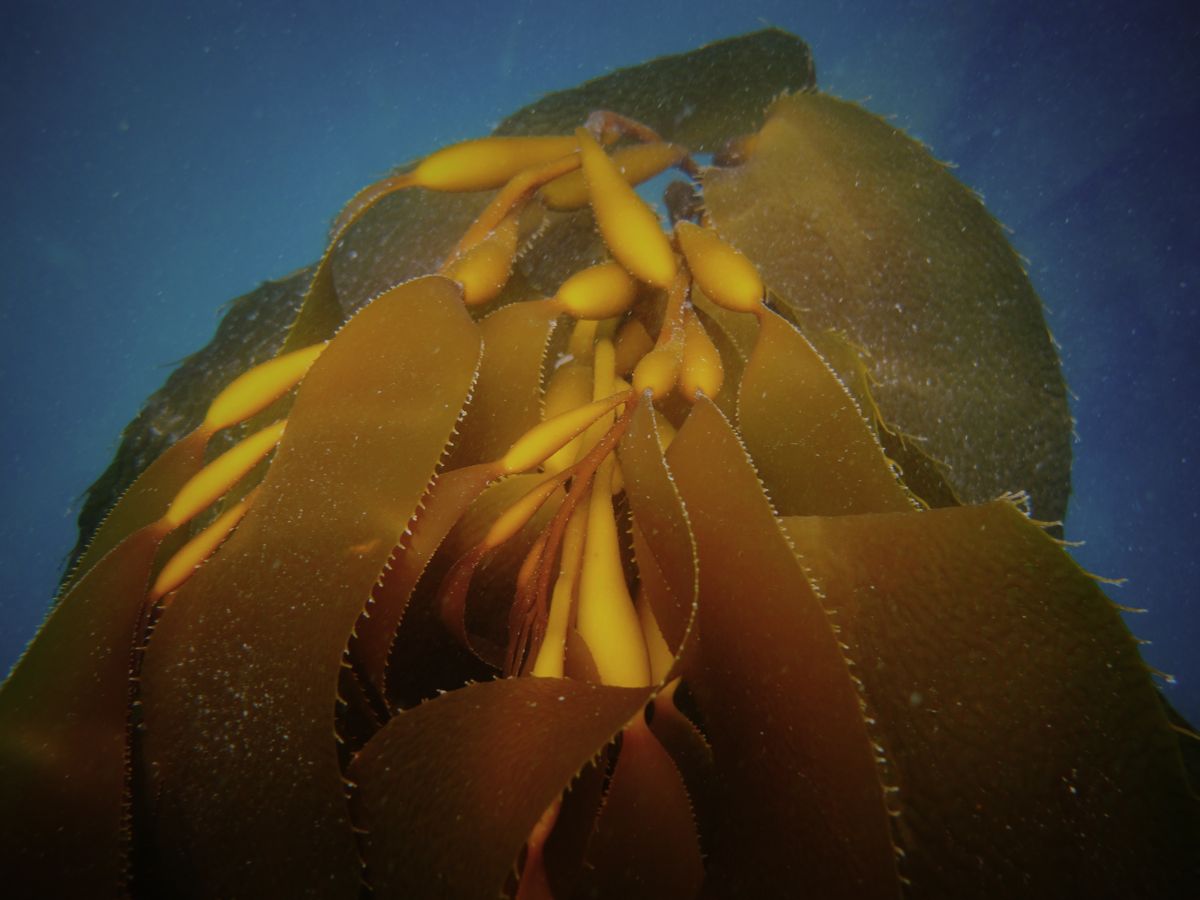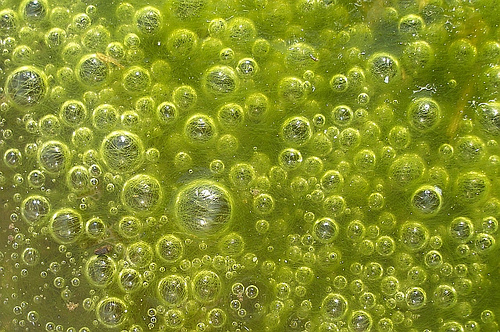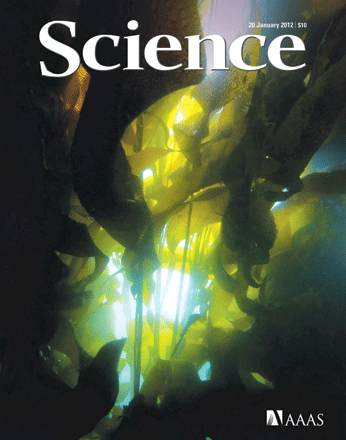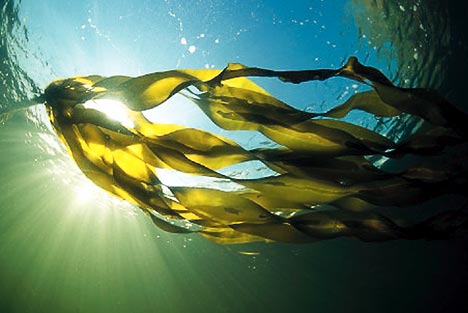A breakthrough in making biofuel from seaweed

Brown seaweed. Image via University of Karachi, Pakistan
|
|
In January 2012, scientists in Berkeley, California published in the journal Science
the results of a method they developed to create biofuel from seaweed.
They say this method makes seaweed a contender for supplying the world
with “real renewable biomass.”
Adam Wargacki and colleagues at the Bio Architecture Lab – whose website is here – genetically engineered a new strain of E. coli bacteria, which can feed on the sugars found in brown seaweed and transform the sugars into ethanol. Prior to this breakthrough, even though it grows rapidly, seaweed has not been used for biofuel because few organisms can consume the sugars that seaweed produces. And ethanol production requires that consumption of sugar. To make biofuel, sugar must be fed to bacteria, which transform the sugar to ethanol.
 Many believe that using seaweed for biofuel production holds promise.
Using seaweed for biofuel overcomes land use and energetic constraints
of current biofuel production. When corn is used to produce ethanol,
debates arise over food versus fuel land use. Culturing a fuel source
in the ocean circumvents this debate. Furthermore, there is also no
demand for freshwater resources when growing seaweed.
Many believe that using seaweed for biofuel production holds promise.
Using seaweed for biofuel overcomes land use and energetic constraints
of current biofuel production. When corn is used to produce ethanol,
debates arise over food versus fuel land use. Culturing a fuel source
in the ocean circumvents this debate. Furthermore, there is also no
demand for freshwater resources when growing seaweed.
On top of bypassing ethical questions about land use, seaweed also contains no lignin. Lignin is one of the most abundant organic molecules on Earth. This molecule is a complex network of carbon atoms that plants construct within their cell walls to help give plants structure and support. The additional advantage of lignin to plants is that even though it is a large molecule, it contains very little energy. The complexity and low energy of lignin means that not many organisms can digest it. Therefore, lignin serves as a deterrent to organisms that want to eat plants. Tough woody structures filled with lignin are difficult for bacteria or fungus to infiltrate and to consume the abundance of energy contained within the biomass of plants.
Because it does not have lignin, more of the seaweed biomass is available to produce ethanol. Therefore, each unit of seaweed contains more potential ethanol than corn or switchgrass.
However, the primary form of sugar in these seaweeds is called alginate.
Unfortunately, no bacteria species was known that could convert
alginate to ethanol. However, unlike lignin, which is low in energy,
alginate contains the energy necessary to produce ethanol.
In January 2012, BAL scientists announced that they had created a genetically modified bacterium that had the correct cellular machinery to convert alginate to ethanol. The ethanol is created in a similar process to making beer. The alginate sugars are fed to the bacteria in an environment without oxygen. If oxygen were present bacteria would transform the sugar into carbon dioxide, the same things humans do when we eat food.
However, in the absence of oxygen, bacteria ferments the sugar and produces ethanol instead.
What does it mean? It means the scientists at the Bio Architecture Lab have made available a new source of ethanol – seaweed – that produces more fuel than plants with lignin and does not require converting any land away from food production.
 Seaweed is one form of algae, and other attempts are also underway to
use algae to produce fuel. In contrast to scientists at BAL, other
researchers focus on using microalgae – which are microscopic
algae, found in both freshwater and ocean systems. Microalgae convert
sunlight or sugar into oil within their cells. These oils are similar
to other common vegetable oils, like soy or canola, and can then be
refined into fuels such as biodiesel, green diesel and jet fuel.
Seaweed is one form of algae, and other attempts are also underway to
use algae to produce fuel. In contrast to scientists at BAL, other
researchers focus on using microalgae – which are microscopic
algae, found in both freshwater and ocean systems. Microalgae convert
sunlight or sugar into oil within their cells. These oils are similar
to other common vegetable oils, like soy or canola, and can then be
refined into fuels such as biodiesel, green diesel and jet fuel.
When grown in the light, these oil-rich algae present a one-step path towards renewable transportation fuels (i.e. sunlight is directly converted to oil). However, some microalgae can also be grown in dark tanks and fed sugars just like the E. coli engineered by BAL, or more commonly yeast. Then one must ask, given a fixed amount of sugar, would you rather feed the sugar to yeast or E. coli and make ethanol – or feed it to algae that make oil? Ultimately, a careful study of the efficiency of these processes and the various energy inputs they require will need to be conducted. For example, microalgal oil production requires energy-intensive aeration of the algae; however, the recovery of the ethanol product from fermentation might require more energy than used for oil processing. The challenge for both these approaches is to extract more energy from the algae than is used to grow the algae and extract the fuel.
Bottom line: Adam Wargacki and colleagues at the Bio Architecture
Lab in Berkeley, California have genetically engineered a new strain of
E. coli bacteria, which can feed on the sugars found in brown seaweed
and transform the sugars into ethanol. They say this method makes
seaweed a “contender” for supplying the world with “real renewable
biomass.” They published their results in the journal Science in January 2012.
Daniel Kammen: Energy from algae is a wildcard
Adam Wargacki and colleagues at the Bio Architecture Lab – whose website is here – genetically engineered a new strain of E. coli bacteria, which can feed on the sugars found in brown seaweed and transform the sugars into ethanol. Prior to this breakthrough, even though it grows rapidly, seaweed has not been used for biofuel because few organisms can consume the sugars that seaweed produces. And ethanol production requires that consumption of sugar. To make biofuel, sugar must be fed to bacteria, which transform the sugar to ethanol.

Brown seaweed growing underwater at one of BAL's Chilean aqua farms. Image credit: Bio Architecture Lab
On top of bypassing ethical questions about land use, seaweed also contains no lignin. Lignin is one of the most abundant organic molecules on Earth. This molecule is a complex network of carbon atoms that plants construct within their cell walls to help give plants structure and support. The additional advantage of lignin to plants is that even though it is a large molecule, it contains very little energy. The complexity and low energy of lignin means that not many organisms can digest it. Therefore, lignin serves as a deterrent to organisms that want to eat plants. Tough woody structures filled with lignin are difficult for bacteria or fungus to infiltrate and to consume the abundance of energy contained within the biomass of plants.
Because it does not have lignin, more of the seaweed biomass is available to produce ethanol. Therefore, each unit of seaweed contains more potential ethanol than corn or switchgrass.
The researchers discussed their research in the January 20, 2012 issue of Science.
In January 2012, BAL scientists announced that they had created a genetically modified bacterium that had the correct cellular machinery to convert alginate to ethanol. The ethanol is created in a similar process to making beer. The alginate sugars are fed to the bacteria in an environment without oxygen. If oxygen were present bacteria would transform the sugar into carbon dioxide, the same things humans do when we eat food.
However, in the absence of oxygen, bacteria ferments the sugar and produces ethanol instead.
What does it mean? It means the scientists at the Bio Architecture Lab have made available a new source of ethanol – seaweed – that produces more fuel than plants with lignin and does not require converting any land away from food production.

Seaweed is one form of algae, and other attempts are also underway to use algae to produce ethanol. Image via rechargenews.com
When grown in the light, these oil-rich algae present a one-step path towards renewable transportation fuels (i.e. sunlight is directly converted to oil). However, some microalgae can also be grown in dark tanks and fed sugars just like the E. coli engineered by BAL, or more commonly yeast. Then one must ask, given a fixed amount of sugar, would you rather feed the sugar to yeast or E. coli and make ethanol – or feed it to algae that make oil? Ultimately, a careful study of the efficiency of these processes and the various energy inputs they require will need to be conducted. For example, microalgal oil production requires energy-intensive aeration of the algae; however, the recovery of the ethanol product from fermentation might require more energy than used for oil processing. The challenge for both these approaches is to extract more energy from the algae than is used to grow the algae and extract the fuel.
Brown seaweed. Image via University of Karachi, Pakistan
Daniel Kammen: Energy from algae is a wildcard



No hay comentarios:
Publicar un comentario